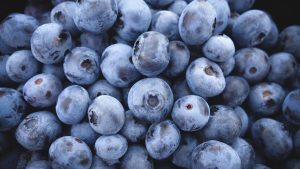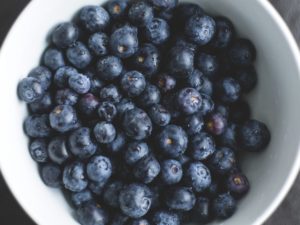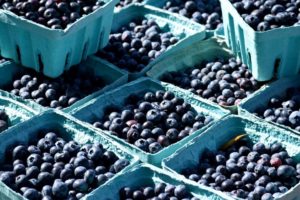Suggested Blueberry Fertilization Timings and Rates
Blueberry plants are sensitive to overfertilization, and the nutrient demand of blueberries is low compared to row crops and vegetables. Blueberry species evolved under the canopy of coniferous forests in acidic soils (4.0-5.4 pH), of which nutrient availability is extremely restricted compared to plants growing in soils at 5.5-6.8 pH. For this reason, overfertilization can cause salt burn to the roots, which is observed as shoot dieback and leaf scorch (Figure 1). This guide explains how to fertilize blueberry to avoid excess nutrient applications while providing adequate plant growth and yield.
If fertilizing solely through the irrigation system (fertigation), overwatering can easily become a problem when fertilizing during periods of rain. Keeping the soil saturated with water can increase root rots. Although fertilizing through the irrigation system is a common practice, establishing the planting with flexibility tofertilize by granular applications and fertigation will reduce the risk of overirrigating blueberry beds.
For blueberry plants, the analyses of the fertilizer (10-10-10, 10-5-5, or 7-0-7) is not as important as the type of nutrients being applied. Blueberry plants will not use nitrate fertilizers. Use ammoniacal sources of nitrogen (N) like ammonia sulfate, ammonia nitrate, or urea, and avoid chlorinated compounds like muriate of potash (KCl) and magnesium chloride (MgCl2). Blueberry fertilizer mixes that are nutrient specific to acidic soil-loving plants are available commercially. Test leaf tissue annually and soil samples at least every third year to get feedback on the effectiveness of your fertilization program.
Blueberry plants are sensitive to elevated levels of salt in the soil, which necessitates multiple fertilizer applications throughout the growing season. In southeastern Georgia commercial blueberry production areas, the soils are well drained but the water table can be close to the surface.
In other regions where soil has poor drainage, is prone to erosion, or has high levels of cation exchange capacity (CEC), modest rates and multiple fertilizer applications can minimize the potential of loss by runoff from heavy rains, leaching of nutrients into ground water, and salt injury from overfertilization.
The following information includes fertilization rate and timing recommendations for southern highbush and rabbiteye blueberries in southern Georgia.
Establishment
When establishing a blueberry planting, it is extremely important to test the soil prior to planting. If the soil pH is above 5.5 and calcium is above 900 lbs/acre, the ground will be unsuitable for planting blueberry. If the calcium is less than 900 lbs/acre but the pH is 5.5 to 6.5, elemental sulfur should be applied prior to planting to lower soil pH. This may take multiple applications. Resample the soil before forming beds for planting, and if the soil pH is still above 5.4, apply and incorporate more elemental sulfur into the soil. Applying and incorporating monoammonium-phosphate (MAP) or diammonium-phosphate (DAP) at 200 lbs/acre during land preparation is suggested to improve establishment, especially if soils are low in phosphorus. After planting, the plants should be watered to settle the soil around the roots. Fertilization should be delayed for four to six weeks, which will allow the roots to expand from the root ball and begin exploring the soil
Years two and three
Maturity
Fertilizer
Fertilizer analysis relates to the amount of nutrient. The first number is nitrogen (N), the second is phosphorous (P), and the third is potassium (K), noted as N-P-K. Some products express the analysis as phosphate (P2O5) and potash (K2O), and in either case these are the first three numbers that indicate the analysis of the fertilizer. Figure 2 offers an example of 10-10-10 granular fertilizer, whose ratio represents 10% N, 10% F, and 10% K. The proportions are numerically reported as percent (%) of the total by weight. If you have 10 lbs of this fertilizer, there will be 1 lb. of N, P, and K, respectively. A complete fertilizer has only N-P-K; however, N-P-K with added nutrients, like secondary nutrients like calcium (Ca) magnesium (Mg), and sulfur (S), and micronutrients like iron (Fe), manganese (Mn), boron (B), zinc (Zn), copper (Cu), nickel (Ni) and others, will be noted on the label and presented as a percent (Figure 2).
Calculations The above recommendations (Tables 1, 2, and 3) express fertilization based on N, and for blueberry plants, the N should be ammoniacal. Below are some example calculations to determine how much N is being applied based on the fertilizer analyses.
Granular fertilizer
Apply 10 lbs of N to an acre with a fertilizer analysis of 10-10-10 granular:
N = 10% by weight or 0.10 per unit weight.
10 lbs N/0.1 N = 100 lbs of 10-10-10 0.1 N
Divide by the decimal form of the percent to calculate the amount N in an application.
If using a fertilizer with an analysis of 12-4-8, how much should be applied at a rate of 10 lbs N/acre?
10 lbs N/0.12 N = 83 lbs of 12-4-8 0.12 N
How much P is applied if using 83 lbs 12-4-8? 83 lbs x 0.04 P = 3.3 lbs P
Liquid fertilizer
What if fertigating with 10-5-5? How much should be applied at a rate of 2 lbs N/acre?
First, what is the density of the fertilizer? Density is mass over volume (mass/volume; g/l or lbs/gallons) and may have been included in the analyses with the liquid fertilizer. If the density is not included, weigh out a gallon of fertilizer. Then calculate the amount of N in each gallon:
Density (mass/volume) x decimal percent of nutrient analysis (10%N/100% = 0.10 N)
= 10 lbs/gal x 0.10 N = 1 lbs N/gal
gal/1 lbs N x 2 lbs N = 2 gal
How to calculate plant density: (1 acre = 43,560 square feet)
acre sq ft/plant spacing = 43560 sq ft/12 ft x 3 ft = 1210 plants/acre
The effect of fertilization can vary depending on the site and cultivar. Water movement through the soil, soil organic matter, and climate can have a tremendous effect on growth rate with any fertilization program. Observation is key todetermining whether the plants are growing sufficiently to support the crop load. Commonly, excessive growth relates to overfertilization, whereas poor growth, reddened leaves, and poor yields may indicate nutrient deficiency. For furtherinformation on blueberry irrigation systems and chemical injection, see University of Georgia Cooperative Extension Bulletin 1504, “Low-Volume Irrigation Systems for Blueberry with Chemigation and Fertigation Suggestions.” If you have other questions, please contact your local UGA Extension Agriculture and Natural Resources agent.
Read more:











